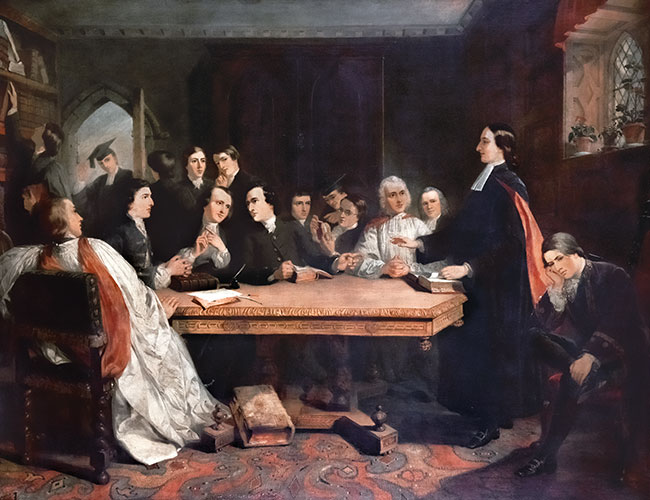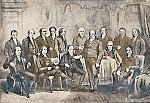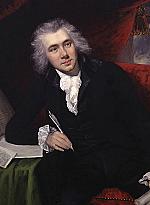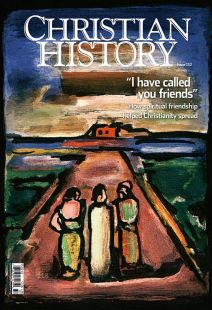Holy clubs and Tuesday meetings

[John Wesley and His Friends at Oxford, Claxton, Marshall, 1813–1881, Photo credit: Salford Museum & Art Gallery]
CHARLES WESLEY (1707–1788) struggled spiritually while a student at Christ Church, Oxford, England. Desiring to grow in faith, in 1729 he formed a group of men called the “Holy Club” to study the Bible, read spiritual books, and pray with each other. At first only three men attended: Charles, his brother John (a fellow at nearby Lincoln College), and their friend William Morgan (see CH #123). John later wrote to Morgan’s father: “Our design was to read over the classics, which we had before read in private, on common nights, and on Sunday some book in divinity.”
Over time more young men joined the gathering, including George Whitefield, Benjamin Ingham, and James Hervey. Whitefield (1714–1770) soon became a legend himself—crisscrossing the Atlantic, preaching across England, Ireland, Scotland, and the British colonies, and spurring on the Great Awakening.
Many at Oxford found the group laughable—and annoying. Other students gave them what they considered to be demeaning nicknames: Reforming Club, Godly Club, Sacramentarians, Bible Moths, Bible Bigots, and Supererogation Men. One name, Methodist, stuck, as it described the system of spiritual method to which group members adhered: Bible study and prayer, fasting, giving generously, evangelizing, and visiting the poor and imprisoned, including some on death row.
Growing in groups
Anglicans had been forming groups for prayer and spiritual disciplines since the mid-1600s. Yet the Wesleys took this concept further. Filled with zeal for God’s truth after profound spiritual experiences in 1738, the Wesley brothers began preaching across England. They discovered that people grew in their faith when organized, just as the brothers had grown through the Holy Club. Borrowing an idea from their friends the Moravians, they organized groups called “bands” divided by gender, marital status, and age for prayer and mutual support.
Eventually bands mostly disappeared and larger coed groups called “societies” replaced them. John Wesley wrote a set of Rules for the United Societies (1743) for his followers; this had no denominational requirement. The only prerequisite for participation was a “desire to flee from the wrath to come, to be saved from their sins.” The purpose of the societies was to encourage each person’s way of “working out their own salvation.” John or Charles (or later, one of their trained lay preachers) appointed a leader over 12 people who met weekly.
As the movement grew, so did the size of the societies. Unusual for the time, the groups included both genders, and women led many class meetings of the societies. These weekly gatherings led by experienced Christians became a foundational part of Methodism. One of the reasons John Wesley initiated these groups was to raise money to build preaching houses—he urged Methodists to receive Communion at their parish churches, but lay self-educated Methodist preachers would not have been allowed into Church of England pulpits. Each member brought a penny, and preaching houses sprang up across England.
Class meetings opened with a hymn or prayer. The leader shared recent spiritual experiences and sometimes a passage from the Bible, and then each member provided a testimony of God’s work in his or her life. They closed in prayer and a hymn. To participate, members needed a current ticket that indicated they had been interviewed about the state of their soul every three months by one of the preachers. A member of the class meeting could join a larger society, which functioned almost like churches we know today. Several class meetings made up a society.
People voluntarily chose to engage in class meetings, but Wesley expelled members if they did not show Christian growth in their lives. He placed them into “penitent bands” if they sought restoration. These provided a safe place for repentant sinners to get help and support in overcoming temptation. Since Methodists forbade drinking distilled liquors, they often met on Saturday evenings to keep members from bars and pubs.
By the time John Wesley died in 1791, the Methodist movement boasted over 71,000 British and over 43,000 American members. Today the World Methodist Council reports a membership of over 40.5 million.
Tuesdays with Methodists
Meanwhile the seeds of a new phase of the movement were being planted. In 1785 a 14-year-old named Henry Worrall from Sheffield, England, joined one of Wesley’s societies, receiving his first membership ticket from John Wesley himself! Worrall married Dorothea Wade and moved to New York City, where he raised his family as Methodists. We remember his daughters Sarah Worrall Lankford (1806–1896) and Phoebe Worrall Palmer (1807–1874) today as the women who started the Holiness movement (see CH #82). But before there was a Holiness movement, there were meetings of spiritual friends called the “Tuesday Meetings for the Promotion of Holiness.”
Why did the idea of small groups meeting together for spiritual encouragement need to be revived among Methodists? Methodists in the colonies under the leadership of Francis Asbury had originally organized themselves into societies and classes as Wesley intended, but this practice had mostly died out by the 1830s. The two sisters would revive it in a new way.
The road to the Tuesday Meetings began with Lankford and Palmer seeking an experience of entire sanctification (also called “Christian perfection,” “holiness,” and the “second blessing”). Both Wesley brothers had written about the possibility of this kind of total consecration to God and testified that they knew believers who had experienced it. Sarah Worrall Lankford claimed entire sanctification in 1835 and began meeting with others who sought it. She and her husband, Thomas, lived with Phoebe and her husband, Walter, so they held the meetings at home.
Jesus saves me as never before
Forty women attended that first meeting. Lankford, who had prayed that the “broad seal of heaven should be affixed [to the meeting],” asked for testimonies. A woman stood and cried out, “Pray for me, pray for me, in the name of the Lord Jesus, I entreat you, pray for me!” They all knelt and prayed for her. Many women claimed, “Jesus saves me this afternoon as never before.” Unlike Wesley’s societies the Tuesday Meetings did not follow a specific formula, but rather included a fluid mix of Bible study, preaching, and prayer.
Yet in the midst of all these holy moments in her own parlor, Phoebe Palmer remained consumed with grief. She had lost two babies in infancy, and in 1836 her three-year-old daughter, Eliza, died after her nurse accidentally threw a lamp into her crib. Unsurprisingly Palmer entered a dark time of the soul. For a year she agonized, cried, and prayed, begging God for entire sanctification.
Finally she testified to the experience in 1837 and began to take a more active role in the meetings. In 1839 Palmer and Lankford welcomed men to the meetings; the next year the Lankfords moved out of the Palmer house and Phoebe Palmer took over the leadership. The meetings grew to include hundreds—with at least four Methodist bishops. People from all parts of the English-speaking world attended.
George Hughes, an attendee, wrote: “The ‘beauty of holiness’ alone has drawn together a weekly attendance of hundreds in a private residence for fifty years.” The textbook for the meetings was never Wesley, but the Bible. Like Wesley’s class meetings, the Tuesday Meetings welcomed people from all denominations. The leaders taught a heavenly cheerfulness and maintained that an inner Christian experience would produce an outer life that revealed faith on the inside.
Eventually, Palmer published The Way of Holiness (1843) and other books to help spread holiness theology, took on a speaking ministry, and (with Walter) became editor of the newspaper Guide to Holiness. After Palmer died at age 66, the recently widowed Lankford married her widower brother-in-law, Walter Palmer, and the two continued to lead meetings and edit Guide to Holiness.
John and Charles Wesley and Sarah Lankford and Phoebe Palmer knew God never meant Christians to travel life’s journey alone. Their organized meetings provided a catalyst for holy friendship. These groups offered a way for Christians to grow in their faith; strong Christians bred strong churches, and strong churches changed the world. CH
By Kelly Diehl Yates
[Christian History originally published this article in Christian History Issue #132 in 2019]
Kelly Diehl Yates is an adjunct faculty member at Southern Nazarene University and is ordained in the Church of the Nazarene.Next articles
Friends united in mission
Gospel-centered friendships abound in church history; here are some milestones for those we focus on in this issue.
Jennifer Woodruff TaitThe Meaux Circle and the Holy Triumvirate
Calvin’s ministry grew out of several partnerships in reform
Jon BalserakSupport us
Christian History Institute (CHI) is a non-profit Pennsylvania corporation founded in 1982. Your donations support the continuation of this ministry
Donate






